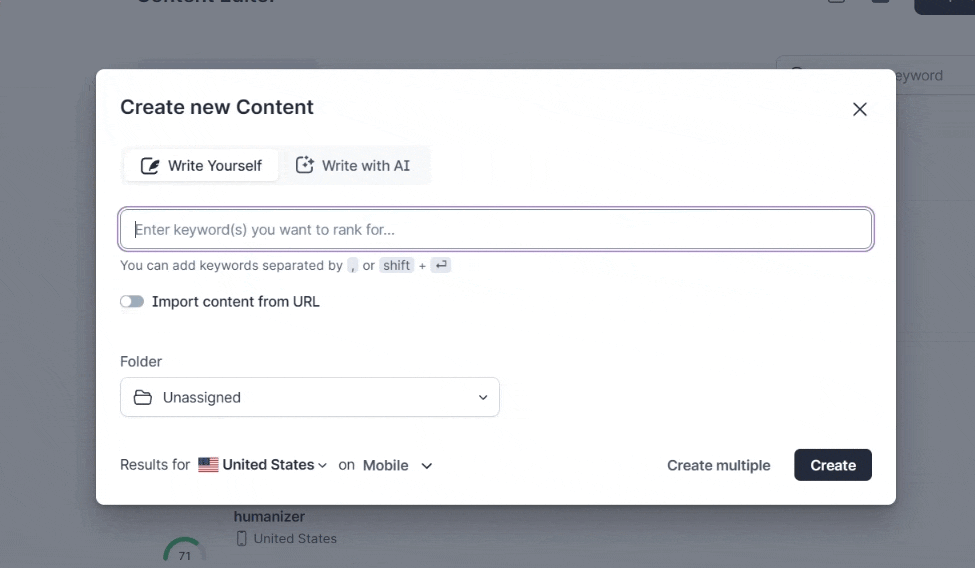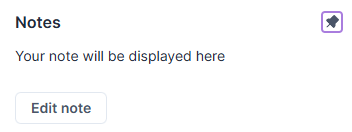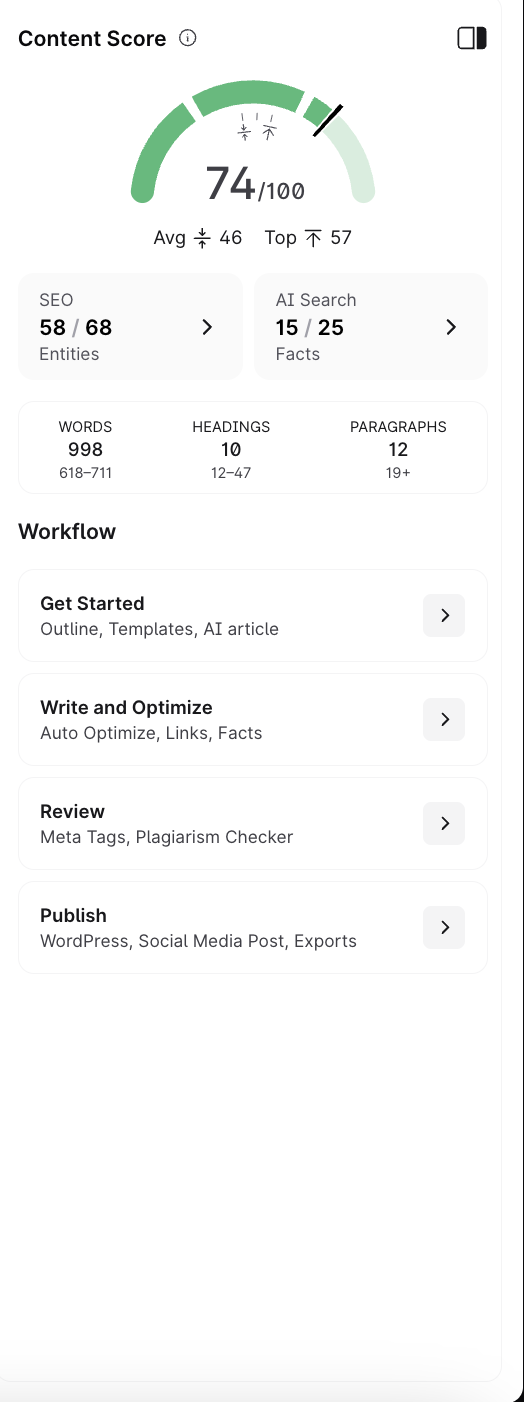
If you want to optimize an existing article immediately, toggle this feature, and we'll do the rest! No need for copy-pasting. We will scan and scrape your content from a URL, import it once the Content Editor is created successfully, and provide you with guidelines and a Content Score.

You can even import content from URLs you previously ran through the Audit tool if you want to work on your audit suggestions instantly.
I encountered problems when fetching my URL 
Auto-Optimize is a feature within Content Editor that you can maximize when aiming to boost your content score.
After you finish writing your content and are ready to optimize it, you can use Auto-Optimize with a single click. Let our algorithms analyze the best opportunities to enhance your content and help it rank higher. We will add relevant NLP terms that will help enrich your content while its original message and meaning remain unchanged. You will be seeing real-time results, and once the tool is finished analyzing your content, a list of suggestions will be displayed on the right panel of your draft.
You can click on a suggestion to see the exact section or heading that was auto-optimized, and you can compare the suggestion vs. the original version. You also have the option to restore the original. Hit save and close after review.
Remember that you will have limited Auto-Optimize runs per month/year, depending on what is included in your Surfer Plan.
I want to learn how Auto Optimize works! 
The Outline tab lists unique and relevant headings, ordered logically to match natural content flow.
In the Outline tab in Content Editor, you will find:
A unique AI-generated outline
Your selected competitors' outlines
Insert Outline button
A section for Notes
 AI Outline
AI OutlineThis outline is generated using advanced AI and competitor analysis, which:
Deduplicates similar headings from competitors
Prioritizes those with relevant terms and SEO value
Orders the headings into a clear and logical structure
Minimizes manual clean-up and editing
Makes the outline more unique and ready-to-use
You can use the outline as-is, or tweak it to match your content direction better. It’s a time-saver that boosts your article's perceived value and uniqueness.
 Competitors' Outlines
Competitors' OutlinesThis view lets you take a sneak peek at your selected competitors' outlines, without leaving the draft page.
It’s a great way to understand how others are structuring content around your target keyword(s), but keep in mind:
These outlines come directly from live competitor pages
They’re meant to inspire, not be copied
Use them to spot common patterns, missing angles, or opportunities for differentiation
If you decide to use any part of a competitor’s outline, edit and adapt it to ensure uniqueness and SEO value
Think of this view as your strategic edge, not a shortcut. Use it to guide smarter decisions in your outline building.
 Insert Outline
Insert OutlineYou can insert the outline into your draft from three different spots:
Under the AI-Generated Outline
Insert the curated outline with one click, directly beneath the outline preview.
Under Competitors' Outlines
Insert a competitor’s outline if you’d prefer to start from an existing structure - remember to tweak it for uniqueness and SEO value.
From the Top Toolbar
Click the Insert Outline icon in the editor toolbar. This option will insert the AI-generated Outline with additional bullet points.
 Tip: Use the AI-generated outline for a ready-to-use, streamlined structure. Use competitor outlines for inspiration or to fill in gaps with ideas others are covering.
Tip: Use the AI-generated outline for a ready-to-use, streamlined structure. Use competitor outlines for inspiration or to fill in gaps with ideas others are covering.
 Notes
NotesThe last section of the Outline tab is a designated space for your notes. You can use it to set deadlines, distribute tasks, add general suggestions, or list your requirements. While Notes are on the bottom of the Outline tab by default, you can easily pin them to the top of the view, depending on your preference.

Note: We've made recent changes in the interface within the editor, namely the Workflow Tab. You can still see the Guidelines quickly under the Guidelines Tab.
Under the Workflow Tab, you'll see five sections:
Get Started: Here, you'll find your Competitors, the Import URL button, and the Outline and Templates button. You can also use, Surfy, our AI Writing Assistant to get things going
Write and Optimize: You can keep on working on your draft by reviewing our suggested terms under SEO Entities and optimize for AI Search by adding Facts. You can also insert automated Internal Links on this step.
Review: Here, you'll find the MetaTitles and Descriptions and Plagiarism Checker.
Publish: This is where you'll find the buttons to Export to WordPress and Create a Social Media Post. You can also export the content you've been working on as an HTML or Markdown.
Change Status: You can mark you content as Done once you've finalized everything.

It's important to remember that if you will open your article from outside the Editor using a Shareable link, this Workflow Tab will not be visibile. Instead, you will still see the old interface.
There are a few ways to share your Content Editor draft, depending on who you're collaborating with:
Copied directly from your browser (e.g., https://app.surferseo.com/drafts/######)
Only accessible to users in your Surfer Organization
Surfer login required
Generated via the “Share” button in the Editor
Can be viewed by anyone with the link — no login needed
Great for sending to writers or collaborators outside your organization
Only one shareable link can exist at a time — to reset access, click “Reset link.”
Install the Surfer extension for Google Docs
Click “Create new Google Document” from the Share menu
Share it like any Google Doc — access is controlled through your Drive
Once created, the regular Surfer shareable link is deactivated
To return to a Surfer shareable link, click “Disconnect from Content Editor”
I want to learn more about Google Docs Extension!
Multiple people can work simultaneously on the same document, regardless of whether it's opened via the private link or a shareable link. You will see how many people are working on the file at the bottom of the page, and you will see real-time updates happening in your content.
You can also use the "Add comment" feature, designed for easier exchange of ideas and feedback amongst teams working together in one article. With comments, you can freely discuss without changing the draft itself.
Just highlight a section or text to prompt the command menu and click "Add comment." A text box will appear so you can write your ideas, suggestions, or feedback.
Collaboration will work for anyone accessing the draft through Surfer, regardless of whether through a shareable link or directly from the Surfer dashboard. Collaboration does not work in Google Docs.
It will only work for Editors created after the feature was released (full release: March 11, 2024). If your draft does not support collaboration, you will see "non-collaborative" information at the bottom.
Anyone with access to the Content Editor can leave a comment, regardless of whether they are a member of the organization.
Do you still need help? Don't worry! You can contact us via live chat by clicking the icon in the bottom-right corner or through [email protected].